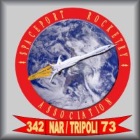 |
Spaceport Rocketry Association Premier rocketry organization serving the Florida Space Coast since 1973 |
| Gallery |
|
Spaceport Rocketry Association Club Record Guidelines |
|
GENERAL INFORMATION ⋅ The flyer attempting a SRA club record must be a SRA member in good standing at the time of the flight. ⋅ The flight must be made at a sanctioned SRA launch and must be conducted at the Rocket Ranch. ⋅ The SRA waiver altitude of 13,500 feet cannot be exceeded. Categories have been selected in an attempt to remain below this altitude, but it is the flyer's responsibility not to attempt a flight that might exceed the waiver limit. A flyer must notify the RSO, and annotate on the SRA Launch Record (LPR) or Launch Card (HPR), if the expected altitude is above 5,000 feet so the flight can be called in to the FAA before launch. ⋅ The flyer must notify a Club Officer of the record attempt prior to the flight (day of launch) and annotate the attempt on the SRA Launch Record (LPR) or on the Launch Card (HPR). ⋅ The flyer will state the specific category and class of the record attempt prior to the flight. One flight, one category and class. ⋅ The flyer will present the rocket and motor to a Club Officer for inspection prior to the flight. Boosted darts are not allowed for setting altitude records and no part of the rocket may be separated, including recovery, except as part of normal staged-flight in those categories. ⋅ Any Club Officer may deny a record attempt prior to launch for safety reasons. ⋅ An approved commercially made and sold altimeter (designed for use in LPR or HPR) must be used to record the altitude. No home-made units, limited production or prototypes are allowed. If in doubt about the acceptability of a specific altimeter, check with a Club Officer. ⋅ The new altitude record must exceed the previous record by 2.0%. For target altitude categories, the difference between the old record and the target altitude must be decreased by 2.0%. ⋅ Motor class will be determined by the total impulse of all motor(s) as tested and not the manufacturer's designation or estimated total impulse. Only certified motors may be used. ⋅ Rockets must successfully deploy their recovery device(s) and have a safe descent. The same standards used in NAR record attempts (no catastrophic failures) shall apply to SRA club records. ⋅ The rocket will be presented to the Club Officer upon recovery for inspection and altitude verification. Maximum altitudes will not be corrected to "standard day". ⋅ The results of the flight will be annotated on the SRA Launch Record (LPR) or on the Launch Card (HPR). A preliminary announcement on the results can be made at the launch, but the official record is subject to verification and approval by the Club Officers. ⋅ The ruling of the Club Officers for any club record attempt is final. |
|
ALTITUDE RECORDS - SINGLE MOTOR CONFIGURATION ⋅ Only rockets using single motors are permitted under this category. No staged or clustered flights are permitted in this category. The following single motor altitude record classes will be maintained:
|
|
ALTITUDE RECORDS - CLUSTERED MOTOR CONFIGURATIONS ⋅ Only rockets using clustered configuration motors are permitted under this category. Clustered strap on boosters are allowed in this category as long as the strap on boosters are retained for the entire flight, including recovery. The following clustered motor altitude record classes will be maintained:
|
|
ALTITUDE RECORDS - STAGED MOTOR CONFIGURATIONS ⋅ Only rockets using staged configuration motors are permitted under this category. Strap on boosters are allowed in this category as long as the "core" motor is ignited in-flight by an onboard ignition system. The following staged motor altitude record classes will be maintained:
|
|
ALTITUDE RECORDS - HANDICAPPED ROCKETS ⋅ These classes have been chosen to reflect industry standard tubing sizes. They are slightly below the standard diameters and have been rounded down to the nearest quarter of an inch. The diameter listed is the minimum diameter, not the maximum diameter. The following large rocket altitude record classes will be maintained based on TRA competition events:
⋅ If a multistage rocket is used, then the uppermost stage must conform to the above diameter and length restrictions. This does not exclude the use of multistage rockets, but does not provide them with an advantage over single stage rockets. |
|
TARGET ALTITUDE RECORDS - SINGLE MOTOR CONFIGURATION ⋅ Only rockets using single motors are permitted under this category. No staged or clustered flights are permitted in this category. Target altitude is 12,000 feet without going over. The following single motor target altitude record classes will be maintained:
|
|
TARGET ALTITUDE RECORDS - CLUSTERED MOTOR CONFIGURATIONS ⋅ Only rockets using clustered configuration motors are permitted under this category. Clustered strap on boosters are allowed in this category as long as the strap on boosters are retained for the entire flight, including recovery. Target altitude is 12,000 feet without going over. The following clustered motor target altitude record classes will be maintained:
|
|
TARGET ALTITUDE RECORDS - STAGED MOTOR CONFIGURATIONS ⋅ Only rockets using staged configuration motors are permitted under this category. Strap on boosters are allowed in this category as long as the "core" motor is ignited in-flight by an onboard ignition system. Target altitude is 12,000 feet without going over. The following staged motor target altitude record classes will be maintained:
|
|
Copyright© 2014 All Rights Reserved |